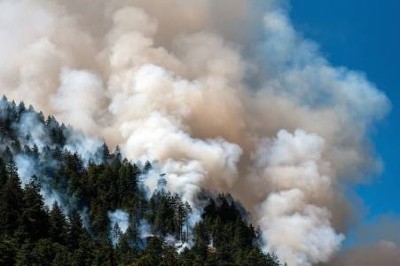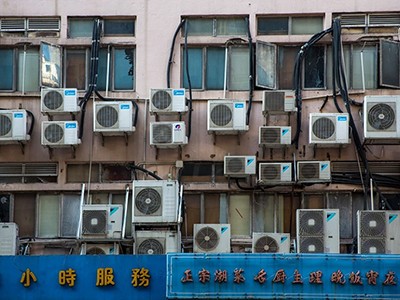Canada’s controversial oil-producing tar sands generate a substantial amount of unaccounted-for carbon-based emissions that can affect air quality, according to measurements taken by aircraft. The sands release more of these pollution-causing gases than megacities such as Los Angeles, California, and about the same as the rest of Canada’s human-generated sources combined — including emissions from motor traffic and all other industries.
“No rules have been broken, or guidelines exceeded here,” says Janetta McKenzie, an oil and gas analyst for the Pembina Institute, a think tank in Calgary, Canada. “But that speaks to some issues in our rules and our guidelines.”

How a dangerous stew of air pollution is choking the United States
The team that conducted the study — led by environmental engineer Drew Gentner at Yale University in New Haven, Connecticut, and chemist John Liggio at the federal agency Environment and Climate Change Canada (ECCC) in Toronto — used an innovative approach to measure all the carbon-based molecules in the air over oil sands in the province of Alberta. The researchers factored out greenhouse gases such as carbon dioxide and instead tracked only molecules important to air quality, many of which haven’t been monitored at the oil sands before. These carbon-based gases can seed particulate pollution in the air and react with other chemicals to form ground-level ozone.
The results, reported in Science on 25 January1, show that these pollution-causing gases from the oil sands are 20 to 64 times what has been detailed in industry reports based on standard monitoring techniques.
“I’m concerned by how big this number is,” says Nadine Borduas-Dedekind, an atmospheric chemist at the University of British Columbia in Vancouver who has worked with Liggio but was not involved with this project. “You want to be measuring all this carbon. For air quality, for health, but also for climate,” she says. Some of the carbon molecules, she notes, will eventually be oxidized to CO2, and therefore also affect climate change.
Liggio says that the ECCC is already working with partners to determine how the paper’s results can improve reporting methods used at the oil sands.
Mark Cameron, a spokesperson for the Pathways Alliance, a coalition of Canada’s largest oil-sands companies, told Nature: “The oil sands industry measures emissions using standards set by ECCC, and we look forward to working together to explore opportunities to further enhance our measurement practices.”
Vast reserve
Canada’s tar sands hold a vast amount of oil, making the country the third largest holder of oil reserves after Saudi Arabia and Venezuela. Various companies have been extracting that oil since the 1960s, but it is locked up in sticky, bituminous sand, so the process is energy- and water-intensive. Production has boomed to more than 3 million barrels of oil per day, generating about 3% of Canada’s gross domestic product.

Why are the Canadian wildfires so bad this year?
The environmental impacts of this massive operation have made it a target for international protest. Global Forest Watch Canada, a non-profit group, estimates that the industry has cleared or degraded 775,500 hectares of boreal forest since 2000. The extra effort and energy needed to extract the oil mean that the sands produce more greenhouse gases per barrel than does conventional oil. And huge tailings ponds in which residue from the extraction process is stored have leaked, raising concerns, in particular for Indigenous peoples living downstream.
Air quality isn’t often highlighted as one of the main problems from tar-sands mining. But the latest study “gives us more things to be thinking about”, Gentner says.
“Having been there, I can tell you it stinks,” Borduas-Dedekind says. “There are Indigenous communities downwind that have complained about the air quality and the smell. If this industry was close to an urban city, there’s no way this would happen. There would be way more outcry.” Nature contacted members of the Fort McKay, Mikisew Cree and Athabasca Chipewyan First Nations who live near the tar sands for comment, but received no response.
Semi-volatile findings
The co-authors of the latest study had previously noticed high levels of particulate pollutants called secondary organic aerosols in the air downwind of the tar sands2, similar in concentration to those downwind of major cities such as Mexico City. So they set out to identify and measure the carbon-based gas emissions that lead to those aerosols.
The team says that most reports of organic emissions look only at a sub-category called volatile organic compounds, which evaporate easily and are usually assumed to account for most air pollution. The new study takes a broader approach, also looking at semi-volatile and low-volatility compounds that vaporize less readily. The whole collection covers probably tens of thousands of compounds, the team says, ranging from small molecules such as acetone to the kinds of heavy carbon-based molecules that might be found in diesel fuel.

Scientists call out rogue emissions from China at global ozone summit
The team collected data from 30 flights over 17 oil-sands operations in 2018. The aeroplane was equipped with an instrument that converted all carbon-based compounds to CO2 so that they could be measured simultaneously, rather than measuring them individually — a much more onerous and impractical task. The team also measured and identified some specific organic compounds, both to get a sense of what made up the mix of emissions, and to remove background levels of the greenhouse gases CO2, methane and carbon monoxide from their measurements. The researchers say this approach would be useful for more comprehensive emissions monitoring of other industries, too. “What they’ve done is really clever,” Borduas-Dedekind agrees.
The findings help to paint a broader picture of pollution from the oil sands, adding to previous research that has highlighted higher-than-expected methane emissions3, for instance. In 2019, Liggio’s group also reported4 that greenhouse-gas emissions from the tar sands are about 30% higher than the industry has measured with standard techniques. The Canadian government is collaborating with industry and other partners now to learn where that discrepancy comes from, Liggio says. “We’re working on it.”
"oil" - Google News
January 26, 2024 at 02:01AM
https://ift.tt/ljuaO2m
Canada's oil sands spew massive amounts of unmonitored polluting gases - Nature.com
"oil" - Google News
https://ift.tt/fUrV6bi
Shoes Man Tutorial
Pos News Update
Meme Update
Korean Entertainment News
Japan News Update
Bagikan Berita Ini














0 Response to "Canada's oil sands spew massive amounts of unmonitored polluting gases - Nature.com"
Post a Comment